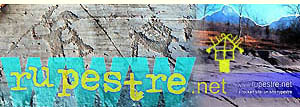in Italiano or en Français

Mt. Bego and Valcamonica are the two most important alpine rock art sites. Regarding the quantity and the quality of engraved rocks we can't find any equal in the other alpine valleys.
In Valcamonica some 200-300.000 engraved figures are estimated to exist, while in Mt. Bego 35,000 engravings were traced (and counted).
Natural blackboards
It is often claimed that this huge concentration was due to the presence of two open air sanctuaries, or sacred mountains.
Although we may consider the possible religious meanings as very important in the choice of this site by the prehistoric artists, we must also consider that the rocks, sandstone in both Mt. Bego and Valcamonica, are not exfoliated, not too hard, and are perfectly polished by the glacier, showing most surfaces similar to a natural blackboard, ready to receive the signs engraved by alpine cultures.
So we must find in the rock itself the main ground for such a large concentration of pecked figures.
The Park
The engraved area in the Mt. Bego region covers (mainly) two valleys: "Valle delle Meraviglie" (valley of marvels) and "Fontanalba" (white fountain). We are in the Maritime Alps, near Tenda. This area was Italian until the second world war. After 1947 it became French, joining with the region of Nice, which had become French by 1860.
The entire engraved zone is inside the National Park of Mercantour, a beautiful high mountain (up to 3000 m) zone in France, except a section on the Italian side, which is included in the Argentera Park.
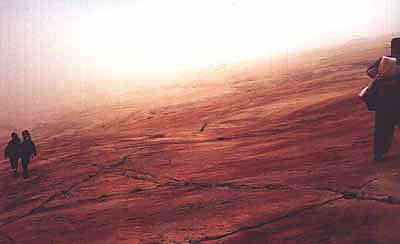 We can find rock engravings
over 2000 m of altitude, up to 2500-2600 m, so the rocks are covered by snow
from October-November till June. When they are free of snow, the engravings
show beautiful colors, from red to green to violet.
We can find rock engravings
over 2000 m of altitude, up to 2500-2600 m, so the rocks are covered by snow
from October-November till June. When they are free of snow, the engravings
show beautiful colors, from red to green to violet.The summer mountain tourism is highly developed; people come to see the engravings but also to walk along alpine paths and to watch wild animals like chamois and ibexes.
Shepherds are still working and living here in summer, taking hundreds of cows and sheep up to the mountain pastures.
The area is well protected by "rangers": in both the "Valle delle Meraviglie" and "Fontanalba" only certain paths are open and free to the public.
To see the engravings best, visitors are advised to join guided tours, departing two or three times each morning, in the summer only. It's not easy to find available places to sleep in the mountain refuges: it's better to phone many weeks before. Here are some useful phone numbers:
- +33-4 93 04 65 32 (Alain SIMON, Gîte le BEGO, Saint Dalmas de Tende, experienced guide, jeep and foot trips, Mobile : 06 88 53 90 46)
- +33-4930.46.464 (Refuge des Merveilles)
- +33-4930.46.922 (Refuge de Fontanalba)
- please use this contact-form if you want to to request a visit program with archaeological guide (English - French - Spanish - Italian spoken)
To reach the first engraved rocks 3-4 hours of hiking are
required in the Valle delle Meraviglie, and 2 hours of hiking in Fontanalba.
The research 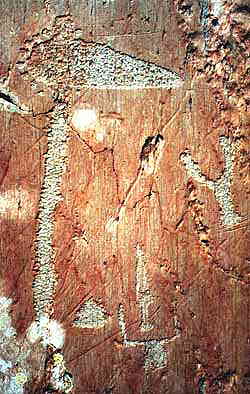
For a a detailed research history you may refer to this paper (in Italian, English abstract available): ARCÀ A. 2012, Piero Barocelli, l’archeologo delle Meraviglie Un pioniere dell’archeologia rupestre italiana ed europea, in Quaderni della Soprintendenza Archeologica del Piemonte, 27, 77-100 (re-published on the Internet by TRACCE Online Rock art Bulletin).
The engraved rocks were
always known by local inhabitants, who called this region the "Valle delle
Meraviglie" (the Marvels valley) . We can find the first written
description in a 1460 letter by Pierre de Monfort (C'etatit lieu infernal
avec que figures de diables et mille démones partout taillez en rochiers -
it was a hell place with devil figures everywhere engraved in the rocks)
and in a 1650 guide written by Pietro Gioffredo (I laghi su menzionati
sono detti laghi delle Meraviglie perché nei loro pressi sono state
rinvenute, e ciò è motivo
di grande meraviglia nei visitatori, rocce di vari colori, quasi levigate,
che portano incise un migliaio di figure - These lakes are called "Lakes
of Marvels" because rocks of various colors were found near them, with
a thousand engraved figures; for this reason visitors are quite astonished.
The first and one of the most important researchers was Sir Clarence BICKNELL,
a British botanist who spent his summers here from 1897 to 1918, documenting
(pictures and 16,000 rubbings) and discovering thousand of engraved signs.
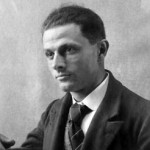
In 1927-1942 Carlo Conti was charged by Piero Barocelli
(here in the picture), inspector of the Piedmont Royal Archaeological
Superintendence and a pioneer of the European rupestrian archaeology,
to study these rocks. He catalogued some 35,000 figures, and dug in the
shelter
"Gias del Ciari" (shelter of the mouse), finding pottery from Cardial
Neolithic to early Bronze Age and some small silex blades. He divided the
region into 21 zones, using Roman notation (I-XXI). Regarding the key role
played by Piero Barocelli in the Mt. Bego research history you may read this TRACCE
Online Rock Art Bulletin paper, which has been published
in the "Quaderni" of the Piedmont Archaeological
Superintendence (QSAP
27, 2012).
Since 1967 the team of Prof. Henry De Lumley is studying the region, completing
a huge project of documentation.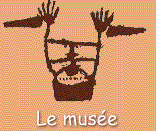
35,000 figures have been traced, and the beautiful new museum of Tenda (with many
moulders perfectly reproducing the most important engraved surfaces) is now
opened to the public.
How to date and interpret
Fora a detailed chronology of the engraved Mt. Bego figures it is possible
to read this paper (in French): ARCÀ A.,
2011. Entre
Bégo et Val Camonica, une clé pour mieux comprendre l'origine
de l'art rupestre dans les Alpes, Bulletin d'études préhistoriques
et archéologiques alpines, XXII, Aoste, pp. 71-89 (re-published
on the Internet by TRACCE
Online Rock art Bulletin).
In Mt. Bego region we can find prehistoric and historic engravings. We can also find pecked engravings and "linear engravings". Pecked engravings are mostly prehistoric, "linear engravings" (easily made by a knife or metal point: please don't do this!) mostly historic.
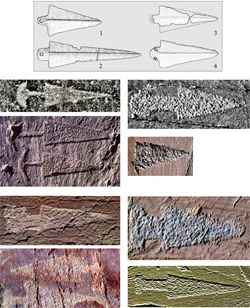
The main typologies of pecked prehistoric engravings are three: horned
figures (80% are cows), weapons (7.5% are daggers and halberds), grid figures
(12.5% are square grids and "topographic" figures).
Some scholars were used to assign the engravings to the ancient Bronze Age (1800-1500 b.C.). Now archaeologists are convinced, as already stated by Piero Barocelli, that the great part of weapon figures belongs to the Copper Age (full and final, III mill. BC). This phase is preceded by the topographic compositions one. For an updated analysis of the Mt. Bego chronology please refer to this TRACCE Online Rock Art Bulletin paper (in French), already published in the BEPAA - Bulletin d'Etudes Préhistoriques et Archéologiques Alpines (2011).
The "topographic" engravings
should be dated to the Neolithic or to the first Chalcolithic period, as demonstrated
by the comparison with the identical figures
of Valcamonica. 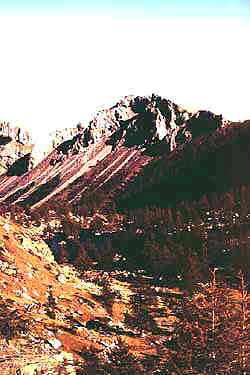 Roman and Greek
inscriptions have been engraved with a scratched (linear engravings) technique,
and the same for medieval and modern ones. So the prehistoric period of Mt.
Bego's pecked engravings range from the late Neolithic to the Ancient Bronze
Age, excluding the Iron Age, which is represented, however, by most of the
engravings in Valcamonica.
Roman and Greek
inscriptions have been engraved with a scratched (linear engravings) technique,
and the same for medieval and modern ones. So the prehistoric period of Mt.
Bego's pecked engravings range from the late Neolithic to the Ancient Bronze
Age, excluding the Iron Age, which is represented, however, by most of the
engravings in Valcamonica.
From this we may guess that because the climate was colder during the Iron
Age, people were not able to make engravings at the higher, much colder altitudes
of Mt. Bego.
Regarding the themes of the engravings, we can easily distinguish between ground-related
figures (topographic figures, cows, ploughing scenes) and war-related figures
(weapons as daggers and halberds).
Ground-related figures seem to be the older ones, often superimposed by daggers.
There was perhaps the influence of pastoral activity, but there was also perhaps
a ritual intention in engraving a figure for cultural evidence or to bring
good luck.
- A lot of thanks to Sassy Turchi, U.S.A. for English editing! -
Books
- BICKNELL C., 1913. Guide to Prehistoric Rock Engravings of the Italian Maritime Alps
- DE LUMLEY H., 1995. Le grandiose et le sacré, Edisud, Aix en Provence
- ARCÀ A. 2009, Monte Bego e Valcamonica, confronto fra le più antiche fasi istoriative. Dal Neolitico all’età del Bronzo Antico, parallelismi e differenze tra marvègie e pitóti dei due poli dell’arte rupestre Alpina, in Rivista di Scienze Preistoriche, LIX, 265-306.
- ARCÀ A., 2011. Entre Bégo et Val Camonica, une clé pour mieux comprendre l'origine de l'art rupestre dans les Alpes, Bulletin d'études préhistoriques et archéologiques alpines, XXII, Aoste, pp. 71-89.
- ARCÀ A. 2012, Piero Barocelli, l’archeologo delle Meraviglie Un pioniere dell’archeologia rupestre italiana ed europea, in Quaderni della Soprintendenza Archeologica del Piemonte, 27, 77-100.
Photo Gallery
- Topographic engravings, Fontanalba (Late Neolithic or first Copper Age)
- Spiral, Fontanalba (First Copper Age?)
- Man holding a halberd, Fontanalba (Late Copper Age)
- Ploughing scene, Fontanalba (Late Copper Age)
- Cow, Fontanalba (Copper Age - Bronze Age)
- Dagger, Valle delle Meraviglie (Ancient Bronze Age)
- Il Mago (the wizard), Valle delle Meraviglie (Bronze Age)
- Halberd, Valle delle Meraviglie (Ancient Bronze Age)
- Walking at Ciappe di Fontanalba (2400 m - Bronze Age)
- See also (6 pictures in the Alpine Rock Art Screensaver)

Sui Sentieri dell'arte rupestre
Le rocce incise delle Alpi, storia, ricerche, escursioni
44 escursioni alle più importanti aree incise delle
Alpi. 184 pagine in bianco e nero e a colori.
Acquistalo
ora online (Paypal
- carta di credito): 10 € in
sconto web comprese spese di spedizione (Italia).
Walking on the rock art paths (in Italian).
The most complete guide to the Alpine rock art . 184 pages, 44
full described trails (I-FR-CH-AU).
158 tracings and pictures, 20 maps, 21 boxes on Alpine culture.
Buy
it directly online (Paypal or Credit Card): 10 € (Italy) or 15 € (Europe)
shipping included.
© Andrea Arcą 30-Jun-96,09:27:58 – updated 2012
